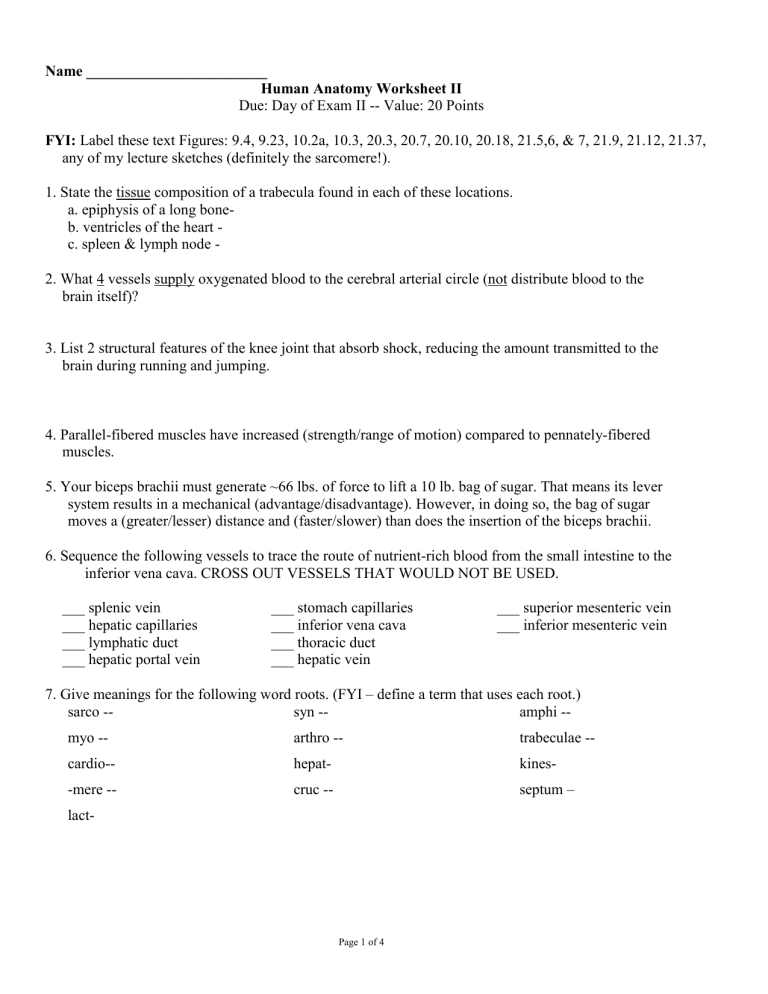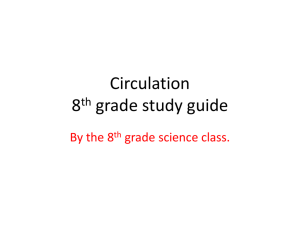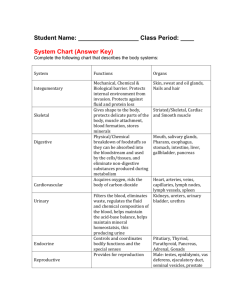Due: Day of Exam II -- Value: 20 Points

Name ________________________
Human Anatomy Worksheet II
Due: Day of Exam II -- Value: 20 Points
FYI: Label these text Figures: 9.4, 9.23, 10.2a, 10.3, 20.3, 20.7, 20.10, 20.18, 21.5,6, & 7, 21.9, 21.12, 21.37, any of my lecture sketches (definitely the sarcomere!).
1. State the tissue composition of a trabecula found in each of these locations. a. epiphysis of a long bone- b. ventricles of the heart - c. spleen & lymph node -
2. What 4 vessels supply oxygenated blood to the cerebral arterial circle (not distribute blood to the brain itself)?
3. List 2 structural features of the knee joint that absorb shock, reducing the amount transmitted to the brain during running and jumping.
4. Parallel-fibered muscles have increased (strength/range of motion) compared to pennately-fibered muscles.
5. Your biceps brachii must generate ~66 lbs. of force to lift a 10 lb. bag of sugar. That means its lever system results in a mechanical (advantage/disadvantage). However, in doing so, the bag of sugar moves a (greater/lesser) distance and (faster/slower) than does the insertion of the biceps brachii.
6. Sequence the following vessels to trace the route of nutrient-rich blood from the small intestine to the inferior vena cava. CROSS OUT VESSELS THAT WOULD NOT BE USED.
___ splenic vein
___ hepatic capillaries
___ stomach capillaries
___ inferior vena cava
___ superior mesenteric vein
___ inferior mesenteric vein
___ lymphatic duct
___ hepatic portal vein
___ thoracic duct
___ hepatic vein
7. Give meanings for the following word roots. (FYI – define a term that uses each root.) sarco -- syn -- amphi -- myo -- cardio-- arthro -- hepat- trabeculae -- kines-
-mere -- lact- cruc -- septum –
Page 1 of 4
8. List 4 extracapsular knee ligaments that prevent hyperextension.
9. Give alternate name(s) for:
intestinal lymphatic capillaries -
circle of Willis-
tunica interna-
meniscus of knee- hunchback - swayback - medial collateral ligament- left AV valve-
10. Metarterioles lead directly into ______ . Precapillary sphincters regulate entry into ______. a. capillaries, venules b. arterioles, venules c. venules, arterioles d. thoroughfare channels, venules e. thoroughfare channels, capillaries
11. The tunica (intima/media/externa) of a blood vessel contains more elastic tissue than the other layers and is thickest in (arteries/veins/capillaries).
12. a. Order the following structures correctly to trace the flow of lymph from the large intestine into the blood.
___ intestinal lymph trunk ___ cisterna chyli ___ efferent lymphatic
___ left subclavian vein ___ thoracic duct ___ afferent lymphatic
___ lymph capillaries ___ interstitial fluid ___ lymph nodes
b. Which two structures above are considered collecting vessels? __________________________
13. Rank these structures from most permeable (1) to least permeable (5).
___ discontinuous capillary ___ lymphatic capillary ___ continuous capillary
___ postcapillary venule ___ fenestrated capillary
14. The azygos vein collects blood from the ________________ veins, and then drains into the _____________ vena cava. The azygos system can function as a by-pass of ______________.
15. Circle which of the following structures contain smooth muscle. efferent lymphatic metarteriole terminal lymphatic dural venous sinus pectinate muscle precapillary sphincter
ductus venosus vena cava
16. Beginning with the fibrous pericardium, list in sequence the tissue layers and spaces a surgeon must penetrate before entering your left ventricle to replace a faulty valve.
17. List the 5 major fetal circulatory modifications, the function of each, and the adult remnant of each.
Page 2 of 4
F.Y.O.G. (For Your Own Good) [but I won’t grade this]
A. List, in sequence, all the chambers, valves, and vessels an RBC would pass through on its journey from the superior vena cava to the thoracic aorta.
B. Create a chart similar to Table 10.4, and be able to fill it in. (Omit rows 8, 9, & 11)
C. Beginning with the superficial fascia, list in sequence, from outermost to innermost, all the connective tissue layers a needle would pierce before hitting the sarcolemma of a myofiber.
D. Review your completed joint lecture charts.
Anatomy Educational Objectives – Exam II
V. Articulations
1.
Define a joint and describe the trade-offs involved in joint strength versus joint mobility.
2.
Describe the four structural categories of joints (and their alternative names), and give an example of each.
3.
Sketch and label the general features of a synovial joint.
4.
Describe the six subcategories of synovial joints, state the axes of motion of each, and give two examples of each.
5.
List six factors that influence the range of motion of any joint.
6.
List the terms used to describe the number of axes of movements possible at a synovial joint and give an example of each.
7.
Define the assigned list of terms describing movements at synovial joints and give an example of a joint at which each movement can occur.
8.
Describe in detail the bones, cartilages, and connective tissues of the knee joint, giving the function of each structure. Be able to identify these features on a sketch.
9.
Describe which structures strengthen the knee joint a) anteriorly, b) laterally, c) posteriorly, and d) internally.
10.
State which structures of the knee joint primarily prevent a) abduction, b) adduction, c) hyperextension, d) anterior displacement of tibia, and e) posterior displacement of tibia.
11.
Explain why the knee joint is the most commonly injured joint in the body.
12.
State the “3 C’s” which are commonly damaged by a lateral blow to the knee.
VI. Muscular System
1.
List four general functions of muscle tissue.
2.
List four general properties of muscle tissue.
3.
List the connective tissue wrappings of a skeletal muscle from superficial to deep and name the structure enclosed by each.
4.
Define origin and insertion with respect to skeletal muscles.
5.
Sketch a simple lever system and label the effort, fulcrum and resistance.
6.
Describe how the body’s skeletal, articular, and muscular systems form lever systems.
7.
Describe the trade-off between mechanical advantage and disadvantage.
8.
Sketch 7 different fascicle arrangements.
9.
Describe the influence of fascicle arrangement on power and range of motion.
10.
Define 4 terms used to describe how muscles work in groups and give an example of each.
11.
Sketch a muscle fiber, labeling all assigned features.
12.
Differentiate between a myofiber, a myofibril, and a myofilament.
13.
Arrange these structures in sequence from largest to smallest: fascicle, myofibril, muscle belly, myofiber, myofilament.
14.
Sketch and label the features of a sarcomere.
15.
List and locate the three major proteins of the sarcomere.
16.
Give a general explanation of the sliding-filament mechanism of muscle contraction, including which features actually shorten during contraction.
17.
Describe the nerve and blood supply to skeletal muscle.
18.
Describe the growth and regeneration of skeletal muscle.
19.
Compare the histology of cardiac and smooth muscle to skeletal muscle.
20.
Compare the nerve and blood supply of cardiac and smooth muscle to skeletal muscle.
21.
Compare visceral smooth muscle to multi-unit smooth muscle.
22.
Define peristalsis and state which smooth muscle type exhibits peristalsis.
23.
Compare the growth and regeneration of cardiac and smooth muscle to skeletal muscle.
Page 3 of 4
VII. Cardiovascular System
1.
Explain why the heart is described as a double pump.
2.
Describe the position of the heart in the body.
3.
Diagram and label the three layers of the pericardium
4.
Sketch and name the layers of the heart wall.
5.
List, from superficial to deep, the structures a surgeon must cut through to reach a chamber of the heart to repair a patent foramen ovale.
6.
Be able to describe and identify all assigned external features of the heart on diagrams.
7.
Describe the functional reason for the difference in wall thickness between atria and ventricles, and between the left and right ventricle.
8.
Be able to label all internal features of the heart on a diagram.
9.
Describe in detail the path of blood flow through the heart, including all chambers and valves.
10.
Describe the structure and function of the heart’s fibrous skeleton.
11.
Sketch the general scheme of coronary circulation.
12.
Describe the histology of blood vessels, including the names of the three layers and the tissues found in each layer.
13.
Give the structural and functional differences between conducting arteries, distributing arteries, resistance arteries & arterioles, capillaries, venules, and veins.
14.
Describe the structural differences between the three types of capillaries and where each type is found in the body.
15.
Diagram and label an arteriovenous anastomosis, indicating its relationship to a capillary bed.
16.
Give an example of an arterial anastomosis and a venous anastomosis.
17.
Compare and contrast the pulmonary and systemic circulations, relating these to differences in thickness of the ventricular walls.
18.
Sketch and label the general scheme of systemic arterial circulation; systemic venous circulation.
19.
Sketch and label the major vessels of the hepatic portal circulation. and describe the general function of the system.
20.
List and diagram the four tributaries to the cerebral arterial circle.
21.
Describe in detail fetal circulation, the modifications that occur at birth, and adult remnants. Be able to identify these features on diagrams.
VIII. Lymphatic System
1.
Describe the 4 general structural components of the lymphatic system.
2.
List 3 general functions for the lymphatic system.
3.
Describe the formation of lymph and state the normal rate of formation.
4.
Describe the structure of all lymphatic vessels, comparing them to blood vessels.
5.
List the tributaries into the thoracic duct and right lymphatic duct.
6.
List, in sequence, the vessels lymph would pass through from its formation in the a) intestinal tract or b) right thumb to its return to the blood.
7.
List 4 factors that power or facilitate flow of lymph to the subclavian veins.
8.
Describe the location and structure of two types of lymphatic tissues.
9.
Describe the location, structure and function of the primary lymph organs.
10.
Describe the location, structure and function of the secondary lymph organs.
11.
Differentiate a lymphatic nodule from a lymphatic organ, including an example of each.
12.
Compare and contrast the structure and function of lymph nodes to the spleen.
Integrative Objective
List at least one structure from each of systems covered in this unit that are composed of dense irregular connective tissue.
Recall and apply all “Deeper Insights” = clinical applications assigned for this unit.
Page 4 of 4








